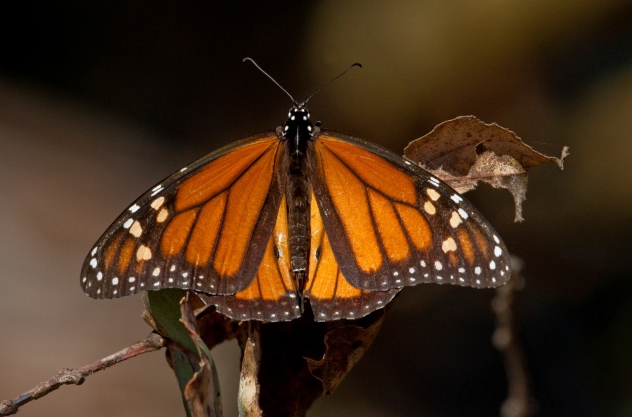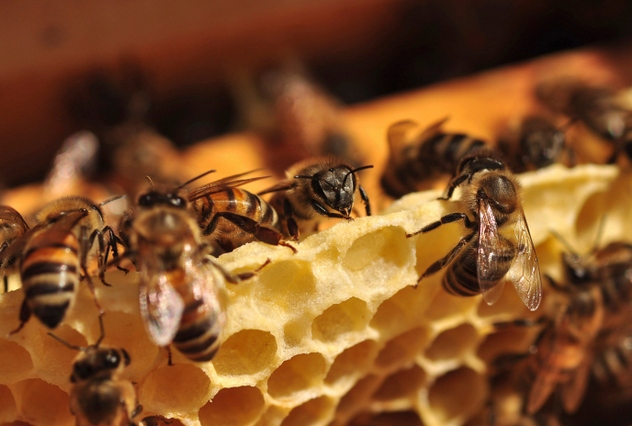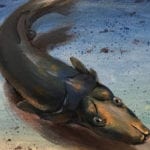 Weird Stuff
Weird Stuff  Weird Stuff
Weird Stuff  Our World
Our World 10 Ways Your Christmas Tree Is More Lit Than You Think
 Movies and TV
Movies and TV The 10 Coolest Stars to Set Sail on The Love Boat
 History
History 10 Things You Didn’t Know About the American National Anthem
 Technology
Technology Top 10 Everyday Tech Buzzwords That Hide a Darker Past
 Humans
Humans 10 Everyday Human Behaviors That Are Actually Survival Instincts
 Animals
Animals 10 Animals That Humiliated and Harmed Historical Leaders
 History
History 10 Most Influential Protests in Modern History
 Creepy
Creepy 10 More Representations of Death from Myth, Legend, and Folktale
 Technology
Technology 10 Scientific Breakthroughs of 2025 That’ll Change Everything
 Weird Stuff
Weird Stuff Ten Bizarre Facts About The Doge Meme
 Our World
Our World 10 Ways Your Christmas Tree Is More Lit Than You Think
 Movies and TV
Movies and TV The 10 Coolest Stars to Set Sail on The Love Boat
Who's Behind Listverse?

Jamie Frater
Head Editor
Jamie founded Listverse due to an insatiable desire to share fascinating, obscure, and bizarre facts. He has been a guest speaker on numerous national radio and television stations and is a five time published author.
More About Us History
History 10 Things You Didn’t Know About the American National Anthem
 Technology
Technology Top 10 Everyday Tech Buzzwords That Hide a Darker Past
 Humans
Humans 10 Everyday Human Behaviors That Are Actually Survival Instincts
 Animals
Animals 10 Animals That Humiliated and Harmed Historical Leaders
 History
History 10 Most Influential Protests in Modern History
 Creepy
Creepy 10 More Representations of Death from Myth, Legend, and Folktale
 Technology
Technology 10 Scientific Breakthroughs of 2025 That’ll Change Everything
10 Invasive Species That Helped The Ecosystems They Inhabit
Nonnative or invasive species are often thought of as doing nothing but damage to the ecosystems they come to inhabit. While some invasive species are indeed causing a great deal of destruction, there are examples of nonnative species being introduced into an ecosystem and doing some good—including several that have contributed to saving an endangered species.
10European Green Crabs And The Salt Marshes Of New England

The European green crab is generally considered one of the most hated of all the invasive species, as it is known to be quite aggressive, eating just about everything it comes across. European green crabs have colonized coasts all over the world, but they have had a surprisingly positive impact in the New England area. Here, overfished salt marshes saw the cordgrass (Spartina alterniflora) nearly eliminated by marsh crabs, a native species of crab. The disruption caused by humans through fishing and other behaviors had limited predators to the native marsh crabs, which proceeded to eat a great deal of the cordgrass while also causing soil erosion due to their burrowing.
With the arrival of the green crab, however, the marshes began to recover. The cordgrass started reappearing in the areas largely populated by green crabs, as the green crabs have taken over, driving the marsh crabs out of their burrows. While the European green crabs have wreaked havoc in many other locations, in New England they have indirectly helped restore an ecosystem ravaged by native species.
9Spartina Grass And The California Clapper Rail

The California clapper rail, an endangered bird species that resides solely in the San Francisco Bay, has taken to nesting in Spartina grass, an invasive species that is at least partially responsible for the eradication of the birds’ habitat. Urban development is the other influencing factor behind the loss of habitat, but the birds have not taken to nesting in the concrete jungle that has encroached on their home. Instead, they have adapted and are now using the invasive grass species as a nesting place.
This has raised problems for researchers in the area, who are left to determine how to best manage the recovery of the endangered clapper rail while also eradicating the invasive species that has become central to its continued survival. This situation has also highlighted the need to determine whether other endangered species may have become similarly dependent on an invasive species in some unknown or unforeseen way, before efforts to remove the invasive species are undertaken.
8Japanese White-Eye And Hawaiian Flowers

The Japanese white-eye, a bird that was brought from Japan to Hawaii in the late 1920s, was initially transported to help control the bug population. The birds quickly spread, and the white-eye is now the most common bird found on the Hawaiian Islands. As other native birds have gone extinct—a decline that is often attributed to the Japanese white-eye’s overwhelming dominance of the islands—many flowering plants have become “widowed” due to the extinction of the pollinating birds. With the birds responsible for pollinating these plants disappearing, the plants, which cannot be found anywhere else in the world, are also threatened with extinction.
Researchers have found, however, that the Japanese white-eye is filling in the gap, pollinating at least two flowering plants that have otherwise been widowed by the extinction of the native birds. It was previously believed that the invasive birds had not contributed anything of value to the island, but the fact that the Japanese white-eye is capable of pollinating both the Mauna Loa clermontia and the small-flowered clermontia seems to indicate that it does hold some value—even if the problem it solves is one that it may have also caused.
7Tamarisk Shrubs And Southwestern Willow Flycatcher Nests

The plight of the southwestern willow flycatcher is the result of so many unintended consequences caused by the repeated efforts of the US government that it borders on comical. Tamarisk trees, also known as salt-cedar shrubs, are an invasive species that were intentionally introduced to the United States to control soil erosion through their large capacity for water consumption. After some time, however, it became clear that the water the tamarisk was consuming was draining riverbanks and destroying the willow trees that the southwestern willow flycatcher used for nesting.
With its natural nesting place limited significantly by the invasive tamarisk trees, the endangered species of bird adapted and began using the tamarisk trees as a place to nest. Despite the fact that the southwestern willow flycatcher was now making its home in the tamarisk trees, the United States Department of Agriculture (USDA) sought to eliminate the trees by bringing in yet another invasive species: leaf-eating beetles imported from central Asia.
Aware that the southwestern willow flycatchers were now using the invasive tamarisk as a home, the Department of Agriculture promised not to release the beetles within 320 kilometers (200 mi) of the birds’ known nesting areas. The USDA also noted that these particular species of beetle could not survive in the areas the endangered birds called home. Of course, the beetles were able to survive in those areas and began destroying the birds’ nesting areas in the tamarisk trees. The use of the beetles as an agent of biological control had to eventually be stopped due to this unintended impact.
6Aldabra Tortoises And The Ebony Trees Of Mauritius

When introducing an invasive species, it certainly helps if it is an extremely close relative of the species whose function it is replacing. This was the case with the Aldabra tortoises that were introduced to the island of Ile aux Aigrettes on a very small scale, starting back in 2000. The massive tortoises—adults frequently check in at 300 kilograms (660 lb)—were brought in with the hope that they could help in the restoration of the island’s endangered ebony forest. Many of the ebony trees had been harvested for firewood, and new growth had been extremely limited.
The ebony trees were not recovering because the arrival of humans on the island resulted in the extinction of not just the native giant tortoises but also of giant skinks and, presumably, flightless dodo birds. Without these animals on the island, there was nothing left to eat the fruit of the ebony trees so that its seeds could grow in places other than where the fruit fell—at the base of the existing and mature ebony trees.
The Aldabra tortoises, despite their status as an invasive species, are close relatives to the giant tortoises that once lived on Ile aux Aigrettes and have thus far successfully functioned in the role that their long-extinct relatives once held. The nonnative tortoises are eating the fruit produced by the ebony trees and dispersing their seeds all over the island. Over a decade after the Aldabra tortoises were introduced, researchers are noting that the endangered ebony forests are beginning to recover. Not only do the tortoises facilitate the spreading of the seeds, they are also aiding in the germination process due to the seeds passing through their digestive systems.
5Yellow-Crowned Night Herons In Bermuda

When the island territory of Bermuda was colonized hundreds of years ago, Bermuda night herons were among the original residents. They quickly became extinct due to the introduction of new predators that fed on the terrestrial birds, along with the fact that humans found the herons “so familiar and tame” that they were easily killed with “stones and staves.”
Without the extinct Bermuda night herons on the island, the population of land crabs (Gecarcinus lateralis) began to grow at an alarming rate, given the fact that the long-since departed herons once counted on the crabs as the main component of their diet. Concerned, the government of Bermuda looked into importing a relative of the extinct heron to replace its role in an ecosystem that had become unbalanced in its absence.
In the late 1970s, yellow-crowned night heron, a relative of the extinct Bermuda night heron, was introduced from Florida to the island as a biological control for the overabundant land crabs. The strategy was a success, and the invasive yellow-crowned night herons now enjoy a self-sustaining population on the island and continue to rely on land crabs for 95 percent of their diet.
4Zebra Mussels And The Great Lakes

There is a lot of criticism heaped at the invasive zebra mussels that inhabit the Great Lakes, and much of that criticism is richly deserved. The mussels are able to spread rapidly and densely, frequently covering everything that they are able to attach themselves to. They have also affected the ecosystem of the waters they invaded by competing with many native species of mussels for food. Some of those species of mussels are already considered endangered.
In addition to the clear and adverse impact on the ecosystem, the zebra mussels are also believed to be the root cause of the Type E botulism poisoning that killed thousands of birds on Lake Michigan in 2008. Investigating scientists have theorized that the zebra mussels filter out the botulism from the water and pass it up the food chain to the predators that eat the mussels, with the botulism eventually finding its way to—and poisoning—the birds who eat the poisoned predatory fish.
Clearly, there is not a lot that is positive about the zebra mussels that plague the Great Lakes. However, it is not all bad, as the waters inhabited by the zebra mussels have been linked to increased health of the salmon population and to improved water clarity. Lake Ontario has benefited in particular, as its visibility has been significantly improved by the presence of the water-filtering zebra mussel.
The newfound water clarity has helped the salmon—and the alewife the salmon feed on—hunt, since they primarily do so by sight. Instead of finding it difficult to locate the shrimp in the once-murky waters of Lake Ontario, the alewife now find and feed on an abundance of easily seen shrimp. The health of the alewife then positively affects the health of the salmon. It should be noted, however, that even these benefits are not enough to offset the extensive damage done by the zebra mussels, as the economic and environmental impact has been significant.
3Multiple Invasive Tree Species And Abandoned Agricultural Land In Puerto Rico

The effects of over-farming a plot of land are firmly established, as soil erosion and compaction often result from unsustainable agricultural practices. In Puerto Rico, many of these degraded plots of land were abandoned, and the native species of trees endemic to Puerto Rico were unable to return to these areas. A number of invasive tree species—including the white siris, the African tulip tree, the rose apple, and many others—have demonstrated that they are able to take over these abandoned agricultural fields in spite of the poor soil conditions.
However, the fact that these trees survive in the degraded agricultural areas is not the most significant—these trees are also crucial to enabling the eventual return of the native tree species. It appears that the initial thriving of the nonnative species eventually leads to native trees being able to grow in the understories. In the case of the African tulip, the invasive tree only dominates the degraded areas for a period of about 40 years. At that point, the native species are able to take over and recolonize after regenerating in the shade of the African tulip.
2California Butterflies, Yellow Star Thistle & Eucalyptus Trees

There are many invasive plant species in California, many of which have been planted for ornamental purposes by well-intentioned Californians. While some of these invasive plants have proved to be toxic to at least three species of butterflies that lay their eggs on them, there are numerous examples of butterflies in California benefiting from the presence of invasive plant species.
Due to the deforestation of native trees along California’s Central Coast, monarch butterflies are increasingly turning to the invasive eucalyptus trees that remain in the area. While the eucalyptus trees are not always strong enough to withstand some of the more severe winter storms occurring along the Central Coast, the butterflies have nonetheless adopted them as a primary overwintering habitat and have been able to survive in the trees.
The yellow star thistle, an invasive weed that is reviled throughout the state of California, has become an important resource for many native butterflies in California’s Central Valley. The yellow star thistle provides these foothill butterflies with a source of nectar that is widely available and easily accessible.
1Honeybees In North America

The honeybee has become so part and parcel to the North American ecosystem that it is easy to forget that it is a nonnative species. The European settlers who migrated to North America in the 1600s brought the honeybees with them. The arrival of the honeybee was so closely associated with the arrival of the Europeans that Native Americans referred to the bees as the “white man’s flies.”
Now that the survival of the honeybee is threatened in North America by colony collapse syndrome, industrial agriculture, mites, and deforestation, there is great concern over how the loss of the honeybee will affect an ecosystem that has come to rely on it for pollinating a wide variety of plant life. That this is the case in spite of the honeybee’s status as an invasive species is illustrative of the positive impact that some nonnative species can have on the ecosystem in which they are introduced.
J. Francis Wolfe is a freelance writer and a noted dreamer of dreams. When he’s not writing, he is most likely waiting for “just one more wave” or quietly reading under a shady tree.








